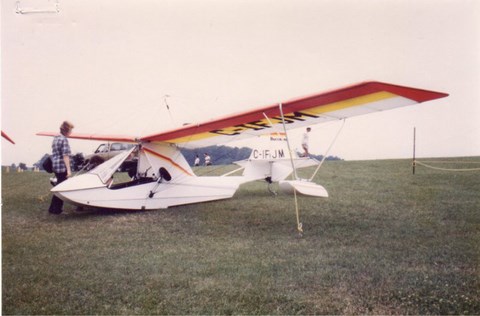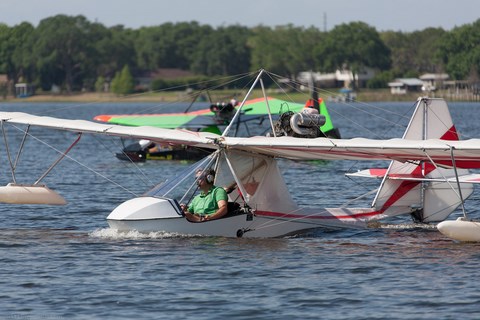Buccaneer XA ultralight aircraft - Troubleshooting the hull.
Due to the restriction put on the manufacturer as far as weight allowance, the hull on the Buccaneer XA's was built as light as possible to fit into the regulations. This unfortunately meant that it was very easily damaged.
The area of damage occurs in several areas,
- Directly below the pilots legs and feet, where two wood stringers are located.
- Directly under the pilot seat, at the step.
- In the back end of the hull.
The damage under the pilots feet is usually caused by a hard landing. The impact separates the two stringers from the fiberglass mat. This leaves only the outer skin and gelcoat to support the craft.
Pilots in Canada strengthened this area by first repairing the hull with glass and cloth from inside. Then fibre glassing aluminium tubes (damaged Eipper nose struts, or rear down tubes work great) into the hull directly beside the wood stringers.
The damage under the pilots seat is caused by hard water landings or landing on a runway with the gear up. To strengthen this area, first refibreglass the damaged area from inside. Then mix a quart of fiberglass resin together with a pound of baking soda. Mix well, then pour it into the step area. Be careful not to much hardener to the resin, or it will cause the mixture to cure to fast and it will crack. When this mixture hardens it turns to a rock hard substance, that adheres very strongly to the hull.
The damage to the tail section is caused when the craft goes in and out of the water. The sand, rocks, etc. will wear through the hull. (As will a landing with the gear up on pavement). This damage is repaired the same was as the step. Mix your resin and backing soda together and pour it into the effected area.
One other thing, when doing the tail section it is necessary to remove the styrofoam floatation from the tail. We have found that this styrofoam can be a source of attitude instability. In many cases where the craft has been sunk, or left out in the open the styrofoam will absorb water. One chunk we took out of a two year old craft weighed over 20 lbs.
Another problem reported in the hull area was with the male and female Velcro used to attach the body sock to the hull. This Velcro looses its "stickiness" when subjected to water, or when continually removed and refastened. The Velcro section that sticks to the hull has also been reported to become detached, especially if left in direct sunlight.
If either happens this can lead to:
- water entering the hull
- the body sock being sucked into the propeller.
Our solution was to install an aluminium strip over top of the Dacron body sock and Velcro strip, fastening the strip by screwing it into the hull. This strip can be obtained from local hardware, or rug stores. It is used to cover the end of a carpet where it goes into a doorway. It has a nice little bend to it and comes with its own screws. After installation we run a bead of silicon along the seam between the aluminium and the hull for added protection.
Another update to the hull area involved the rear section of the aircraft. Many pilots, and several writers, who flew the aircraft complained about water entering the hull during taxiing. To cure the problem a piece of foam was added that better sealed the rear of the hull off from the water, and the three main tubes were capped to prevent water from entering them.
Another area that was updated to prevent water from entering the hull was the main gear support tube. It was found that water would enter between the hull plate and hull gasket. Siliconing this area help prevent the leaking. Later models came with a rubber "inner tube" like material which fit snugly over the main gear support tube and prevented leakage.
The gear leg stop was also changed. This aluminium plug fits into the landing gear, acts as a stop and prevents it from turning. The plug is held in place by a 1/4 inch bolt. The original bolts were fine thread. It was found that these stripped very easily and were later replaced by a course thread insert and bolt.
Buccaneer XA ultralight aircraft - Troubleshooting the hull.
Another update to the hull area involved the rear section of the aircraft. Many pilots, and several writers, who flew the aircraft complained about water entering the hull during taxiing. To cure the problem a piece of foam was added that better sealed the rear of the hull off from the water, and the three main tubes were capped to prevent water from entering them.
Another area that was updated to prevent water from entering the hull was the main gear support tube. It was found that water would enter between the hull plate and hull gasket. Siliconing this area help prevent the leaking. Later models came with a rubber "inner tube" like material which fit snugly over the main gear support tube and prevented leakage.
The gear leg stop was also changed. This aluminium plug fits into the landing gear, acts as a stop and prevents it from turning. The plug is held in place by a 1/4 inch bolt. The original bolts were fine thread. It was found that these stripped very easily and were later replaced by a course thread insert and bolt.
Another update to the hull area involved the rear section of the aircraft. Many pilots, and several writers, who flew the aircraft complained about water entering the hull during taxiing. To cure the problem a piece of foam was added that better sealed the rear of the hull off from the water, and the three main tubes were capped to prevent water from entering them.
Another area that was updated to prevent water from entering the hull was the main gear support tube. It was found that water would enter between the hull plate and hull gasket.
Siliconing this area help prevent the leaking. Later models came with a rubber "inner tube" like material which fit snugly over the main gear support tube and prevented leakage.
The gear leg stop was also changed. This aluminium plug fits into the landing gear, acts as a stop and prevents it from turning. The plug is held in place by a 1/4 inch bolt.
The original bolts were fine thread. It was found that these stripped very easily and were later replaced by a course thread insert and bolt.



